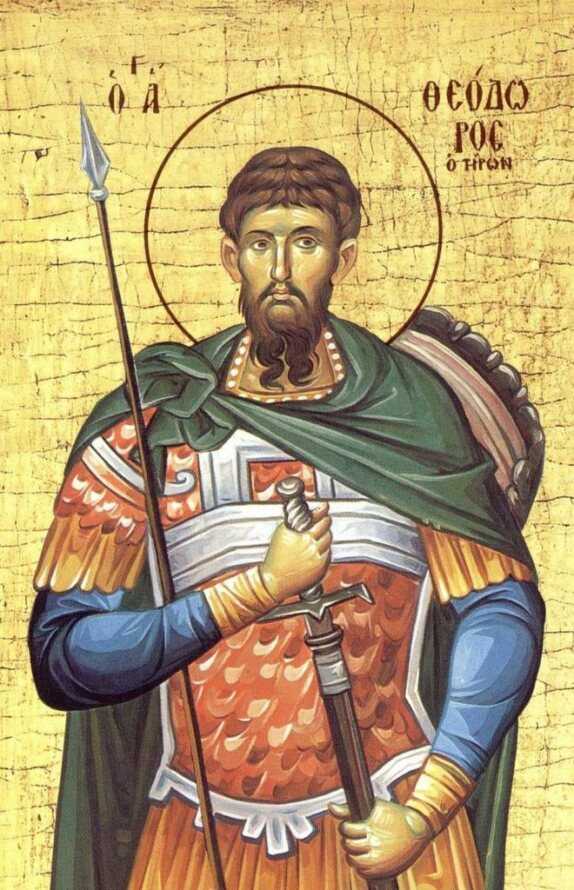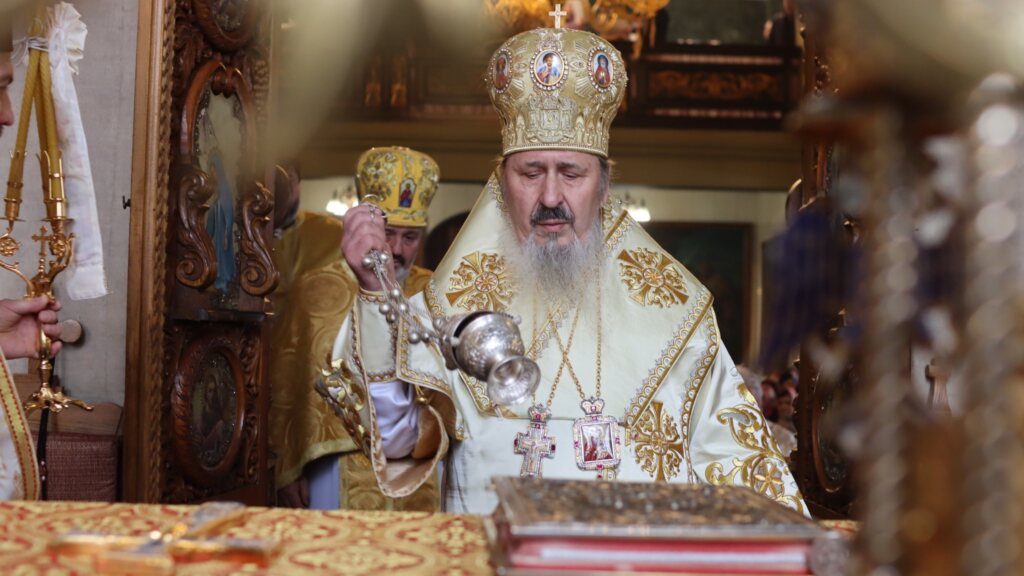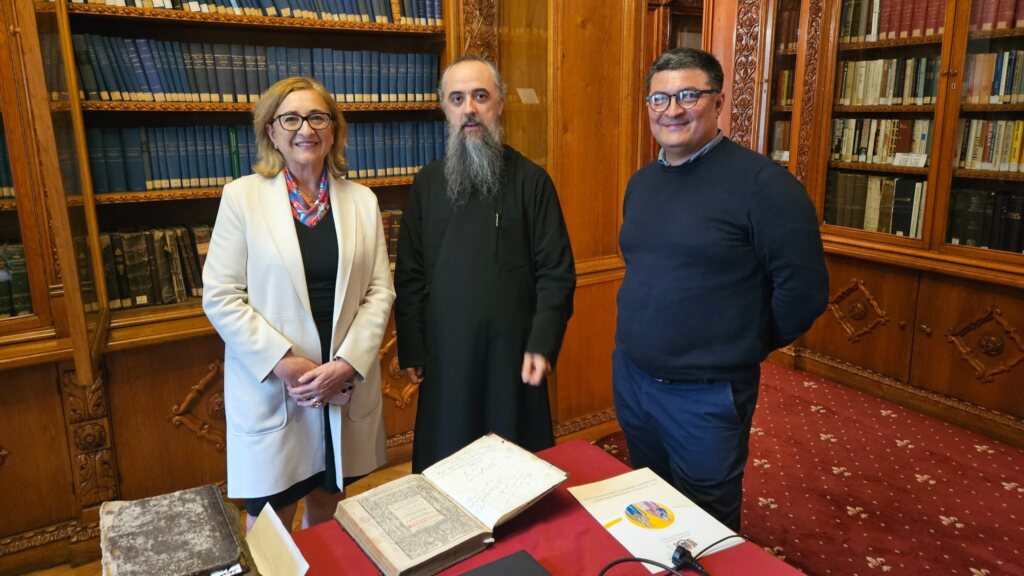Orthodox Calendar – February 17
The Holy Great Martyr Theodore the Recruit (Tyro)
The martyr was a soldier in the city of Alasium of the Pontine district (northeast province of Asia Minor, stretching along the coast of the Euxine, i.e. the Black Sea), under the command of a certain Brincus. They commanded him to offer sacrifice to idols. Saint Theodore firmly confessed his faith in Christ the Savior in a loud voice. The commander gave him several days to think it over, during which time Saint Theodore prayed.
They charged him with setting a pagan temple on fire, and threw him into prison to be starved to death. The Lord Jesus Christ appeared to him there, comforting and encouraging him. Brought to the governor, Saint Theodore boldly and fearlessly confessed his faith, for which he was subjected to new torments and condemned to burning. The martyr Theodore climbed onto the fire without hesitation, and with prayer and gave up his holy soul to God.
This occurred in about the year 306 under the Roman emperor Galerius (305-311). Unharmed by the fire, the body of Saint Theodore was buried in the city of Euchaita, not far from Amasium. His relics were afterwards transferred to Constantinople, to a church dedicated to him. His head is in Italy, in the city of Gaeto.
Later on, fifty years after the death of Saint Theodore, the emperor Julian the Apostate (361-363), wanting to commit an outrage upon the Christians, commanded the city-commander of Constantinople during the first week of Great Lent to sprinkle all the food provisions in the marketplaces with the blood offered to idols. Saint Theodore appeared in a dream to Archbishop Eudoxius, ordering him to inform all the Christians that no one should buy anything at the marketplaces, but rather to eat cooked wheat with honey (kolyva).
In memory of this occurrence, the Orthodox Church annually celebrates the holy Great Martyr Theodore the Recruit on the first Saturday of Great Lent. On Friday evening, at the Divine Liturgy of the Presanctified Gifts following the prayer at the ambo, the Canon to the holy Great Martyr Theodore, composed by Saint John of Damascus, is sung. After this, kolyva is blessed and distributed to the faithful. The celebration of the Great Martyr Theodore on the first Saturday of Great Lent was set by the Patriarch Nectarius of Constantinople (381-397).
Troparion — Tone 2
Great are the accomplishments of faith, / for the Holy Martyr Theodore rejoiced in the fount of flames as though at the water of rest;1 / for having been made a whole burnt offering in the fire / , he was offered as a sweet bread to the Trinity. / By his entreaties, O Christ God, save our souls!
Righteous Mariamne
“The Apostolic Virgin” and sister of the holy Apostle Philip (November 14), made a vow of virginity and became the companion of her brother Philip and the holy Apostle Bartholomew (June 11), actively assisting them in their apostolic work.
The Church historian Nicephorus Callistus describes their successful preaching in the Phrygian city of Hieropolis, where they were arrested and locked up in prison. They put the Apostle Philip to death on a cross, but Saint Mariamne and Saint Bartholomew were set free. Saint Bartholomew went to preach the Gospel in India.
Saint Mariamne, after burying the body of Saint Philip, preached the Gospel at Lykaonia (Asia Minor). She died there in peace.
Troparion — Tone 8
In you the image was preserved with exactness, O Mothers, / for taking up your cross, you followed after Christ. / By so doing, you taught us to disregard the flesh, for it passes away, / but to care instead for the soul, since it is immortal. / Therefore, most venerable Mothers Mariamne and Perozhavra your spirits rejoices with the Angels.
Holy Emperors Marcianus and Pulcheria
Saint Pulcheria was born in 399, in the family of Emperor Arcadius and Empress Eudoxia. She was the older sister of Emperor Theodosius II. On May 1, 408, Emperor Arcadia passed away in Constantinople. His four children, Pulcheria, Theodosius, Arcadia and Marina, were orphaned. At that time, Saint Pulcheria was nine years old.
The imperial throne was inherited by the emperor’s son, Theodosius II. Because he was still a minor, Antimus, a minister of the former emperor and a good friend of St. John Chrysostom, took care of the affairs of the empire for a time.
On July 14, 414, although she was only 16, St. Pulcheria was proclaimed regent. She received the title of Augusta from the Senate. She was entrusted with the care of her younger brother, the future emperor Theodosius II. She ruled the empire until her brother came of age.
At the urging of his sister, Emperor Theodosius convened the Third Ecumenical Council, convened in the city of Ephesus in 431. Now Nestorian heresy was condemned and officially given the title of “Mother of God.”
On July 29, 450, Emperor Theodosius II fell off his horse and died. Thus, the worthy Pulheria became the mistress of the empire again.
To strengthen her power, she married the faithful Marcian, a general and senator from Pannonia, Thrace. He was a widower, and the two lived in purity, although married. Pulheria crowned him emperor in front of the Senate on August 24, 450.
The Holy Empress Pulheria and the Holy Martian Emperor convened the Fourth Ecumenical Synod in the city of Chalcedon in 451. The Synod condemned the heresy of Eutychius and strengthened the right faith of the first three Ecumenical Synods.
The Holy Empress Pulheria passed away on September 10, 453, at the age of 54. She was buried with great honor. He distributed his entire fortune to the poor. Saint Marcian continued to rule alone, strongly defending the decisions of the Council of Chalcedon. Saint Marcian passed to the eternal ones in the year 457.
Troparion of Holy Empress Pulcheria, Tone 4
Holy Empress Pulcheria, entreat our Merciful God to give our souls forgiveness for our sins.
Tr by oca.org






